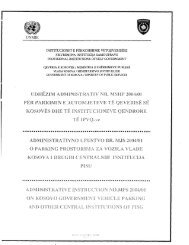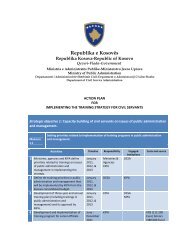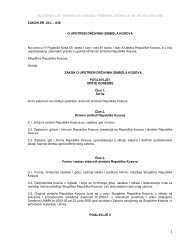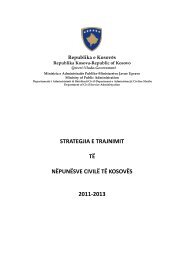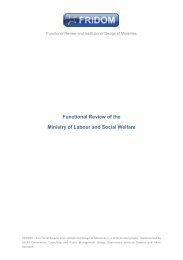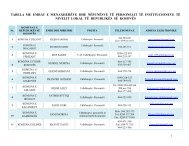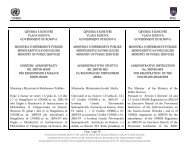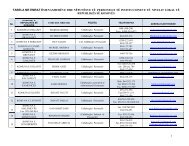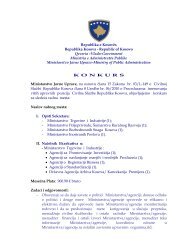Functional Review of the Ministry of Environment and Spatial Planning
Functional Review of the Ministry of Environment and Spatial Planning
Functional Review of the Ministry of Environment and Spatial Planning
You also want an ePaper? Increase the reach of your titles
YUMPU automatically turns print PDFs into web optimized ePapers that Google loves.
<strong>and</strong> summed up for <strong>the</strong> whole ministry. We recommend to complete <strong>the</strong> planning activities with a mediumterm<br />
focus, <strong>and</strong> to add a top-down kick-out phase to <strong>the</strong> process that would clearly set up ministry wide<br />
priorities right at <strong>the</strong> beginning. A monitoring procedure that would report <strong>the</strong> achievements <strong>and</strong>/or failures<br />
to MESP top-management should be established as well.<br />
We also recommend establishing a steering group for strategy formulation, covering department <strong>and</strong><br />
agency heads. The department <strong>and</strong> agency heads already meet on a regular (weekly) basis with <strong>the</strong><br />
Minister <strong>and</strong>/or Permanent Secretary <strong>and</strong> could adopt this role. A clear strategy formulation procedure,<br />
written instructions with responsibility <strong>and</strong> timelines, <strong>and</strong> reservation <strong>of</strong> sufficient time span to discuss <strong>the</strong><br />
strategy is required. . We suggest appointing for special occasions a working group or ad hoc committee<br />
to solve particular problem. This practice is common in <strong>the</strong> environmental administration throughout EU.<br />
The Permanent Secretary bears managerial responsibility for development within <strong>the</strong> <strong>Ministry</strong>. With<br />
several units <strong>and</strong> all agencies out <strong>of</strong> his direct reach, this responsibility can only be enforced to a limited<br />
extent. The PS is carrying a significant administrative load with a total <strong>of</strong> 13 structural MESP units reporting<br />
directly to him along with numerous o<strong>the</strong>r responsibilities <strong>and</strong> functions. The number <strong>of</strong> units reporting<br />
directly to <strong>the</strong> PS is probably too high <strong>and</strong> certainly too fragmented. As can be seen from <strong>the</strong> organigram<br />
<strong>and</strong> <strong>the</strong> staff list <strong>the</strong> PS does not have any deputies.<br />
The ability <strong>of</strong> a public administration to formulate <strong>and</strong> implement coherent policies <strong>and</strong> strategies is a key<br />
indicator <strong>of</strong> administrative capacity. This chapter addresses <strong>the</strong> decisive issue whe<strong>the</strong>r <strong>and</strong> how <strong>the</strong> current<br />
environmental administration satisfies <strong>the</strong> requirements in domestic <strong>and</strong> in <strong>the</strong> international contexts. Its<br />
performance in this regard can be best assessed by reviewing <strong>the</strong> administrative results achieved to date<br />
in Kosovo as <strong>the</strong>y relate to <strong>the</strong> key environmental administration functions as defined elsewhere in this<br />
report.<br />
The MESP has developed several short <strong>and</strong> medium-term sectoral strategies <strong>and</strong> planning documents<br />
(some <strong>of</strong> <strong>the</strong>m by <strong>the</strong> foreign experts or under <strong>the</strong>ir supervision) which contain clear strategic objectives<br />
<strong>and</strong> performance indicators. The overall policy planning, evaluation <strong>and</strong> monitoring capacity in <strong>the</strong> MESP<br />
is very limited which is also reflected in absence <strong>of</strong> up-to-date policy planning documents in policy sectors<br />
except for spatial planning. However o<strong>the</strong>r environmental sectors, i.e. water <strong>and</strong> wastewater management,<br />
solid waste management, air quality, inspection <strong>and</strong> enforcement, nature conservation <strong>and</strong> biodiversity<br />
protection are still without definition <strong>of</strong> clear vision, mission <strong>and</strong> values <strong>and</strong> valid medium term policy<br />
documents. The policy planning process in <strong>the</strong> <strong>Ministry</strong> is operational in nature, predominantly for oneyear<br />
periods at a time <strong>and</strong> typically takes <strong>the</strong> shape <strong>of</strong> annual programming policy documents – compact<br />
1-2 page long documents defining objectives, describing choice <strong>of</strong> measures <strong>and</strong> justifying budget<br />
expenditure for <strong>the</strong> specific policy programme / activity.<br />
The Kosovo <strong>Environment</strong> Action Plan 2006-2010 (KEAP) brings a comprehensive list <strong>of</strong> priority projects<br />
spread over all significant areas <strong>of</strong> environmental interest. The law on <strong>Environment</strong>al protection [No.<br />
2009/03 L-025 (Art. 24)] requires preparation <strong>of</strong> Local <strong>Environment</strong>al Action Plans (LEAPs). The actual<br />
situation is that only few municipalities have prepared a LEAP in Kosovo.<br />
More impact <strong>and</strong> priority is attributed to European Partnership Action Plan (EPAP) adopted in 2008 <strong>and</strong><br />
updated in 2009. It is a general document addressing most economic <strong>and</strong> social issues, which covers also<br />
environment, spatial planning <strong>and</strong> housing. Although, it follows <strong>the</strong> priorities listed by KEAP 2006-2010, it<br />
is more concrete in designating <strong>the</strong> necessary follow-up.<br />
O<strong>the</strong>r important documents covering a narrower focus possess a high value. –These include <strong>the</strong><br />
<strong>Environment</strong> <strong>and</strong> <strong>Spatial</strong> <strong>Planning</strong> section <strong>of</strong> <strong>the</strong> Program <strong>of</strong> <strong>the</strong> Government <strong>of</strong> Republic <strong>of</strong> Kosovo 2008<br />
– 2011,<strong>the</strong> Sectoral Strategy for <strong>Spatial</strong> <strong>Planning</strong> 2007 – 2013 <strong>and</strong> Business Plan for <strong>the</strong> Kosovo<br />
Cadastral Agency 2009 – 2014..<br />
The preparation <strong>of</strong> <strong>the</strong>se strategies <strong>and</strong> plans is required by law <strong>and</strong> visibly affects <strong>the</strong> administration<br />
involved. However <strong>the</strong>ir actual realization is far behind expectations.<br />
Recommendation II.7: Place <strong>and</strong> define strategic <strong>and</strong> policy planning process within <strong>the</strong> MESP <strong>and</strong><br />
create efficient steering mechanisms to implement policy strategies top-down. Elaborate medium term<br />
strategy documents for each sector.<br />
16



